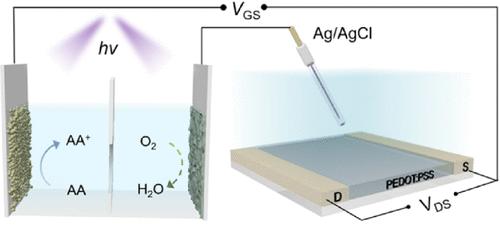当前位置:
X-MOL 学术
›
Anal. Chem.
›
论文详情
Our official English website, www.x-mol.net, welcomes your
feedback! (Note: you will need to create a separate account there.)
Dual Engine Boosts Organic Photoelectrochemical Transistor for Enhanced Modulation and Bioanalysis
Analytical Chemistry ( IF 6.7 ) Pub Date : 2024-04-19 , DOI: 10.1021/acs.analchem.4c01369 Xing-Wu Jiang 1, 2 , Peng Ju 3 , Zheng Li 2 , Bo-Han Kou 2 , Xiaofan Zhai 4 , Feng-Zao Chen 5 , Yuan-Cheng Zhu 2 , Yi-Tong Xu 2 , Zhaoxia Lu 1, 6 , Wei-Wei Zhao 2
Analytical Chemistry ( IF 6.7 ) Pub Date : 2024-04-19 , DOI: 10.1021/acs.analchem.4c01369 Xing-Wu Jiang 1, 2 , Peng Ju 3 , Zheng Li 2 , Bo-Han Kou 2 , Xiaofan Zhai 4 , Feng-Zao Chen 5 , Yuan-Cheng Zhu 2 , Yi-Tong Xu 2 , Zhaoxia Lu 1, 6 , Wei-Wei Zhao 2
Affiliation

|
Organic photoelectrochemical transistor (OPECT) has shown substantial potential in the development of next-generation bioanalysis yet is limited by the either-or situation between the photoelectrode types and the channel types. Inspired by the dual-photoelectrode systems, we propose a new architecture of dual-engine OPECT for enhanced signal modulation and its biosensing application. Exemplified by incorporating the CdS/Bi2S3 photoanode and Cu2O photocathode within the gate-source circuit of Ag/AgCl-gated poly(3,4-ethylenedioxythiophene):poly(styrenesulfonate) (PEDOT:PSS) channel, the device shows enhanced modulation capability and larger transconductance (gm) against the single-photoelectrode ones. Moreover, the light irritation upon the device effectively shifts the peak value of gm to zero gate voltage without degradation and generates larger current steps that are advantageous for the sensitive bioanalysis. Based on the as-developed dual-photoelectrode OPECT, target-mediated recycling and etching reactions are designed upon the CdS/Bi2S3, which could result in dual signal amplification and realize the sensitive microRNA-155 biodetection with a linear range from 1 fM to 100 pM and a lower detection limit of 0.12 fM.
中文翻译:

双引擎增强有机光电化学晶体管以增强调制和生物分析
有机光电化学晶体管(OPECT)在下一代生物分析的发展中显示出巨大的潜力,但受到光电极类型和通道类型之间非此即彼的情况的限制。受双光电极系统的启发,我们提出了一种双引擎 OPECT 的新架构,用于增强信号调制及其生物传感应用。通过将 CdS/Bi 2 S 3光电阳极和 Cu 2 O 光电阴极合并到 Ag/AgCl 门控聚(3,4-乙撑二氧噻吩):聚(苯乙烯磺酸)(PEDOT:PSS)通道的栅源电路中,该器件与单光电极相比,表现出增强的调制能力和更大的跨导( g m )。此外,器件上的光刺激有效地将g m的峰值移至零栅极电压而不会降低,并产生更大的电流阶跃,这有利于灵敏的生物分析。基于已开发的双光电极 OPECT,在 CdS/Bi 2 S 3上设计了靶介导的回收和蚀刻反应,可实现双信号放大并实现线性范围为 1 的灵敏 microRNA-155 生物检测。 fM 至 100 pM,检测下限为 0.12 fM。
更新日期:2024-04-19
中文翻译:

双引擎增强有机光电化学晶体管以增强调制和生物分析
有机光电化学晶体管(OPECT)在下一代生物分析的发展中显示出巨大的潜力,但受到光电极类型和通道类型之间非此即彼的情况的限制。受双光电极系统的启发,我们提出了一种双引擎 OPECT 的新架构,用于增强信号调制及其生物传感应用。通过将 CdS/Bi 2 S 3光电阳极和 Cu 2 O 光电阴极合并到 Ag/AgCl 门控聚(3,4-乙撑二氧噻吩):聚(苯乙烯磺酸)(PEDOT:PSS)通道的栅源电路中,该器件与单光电极相比,表现出增强的调制能力和更大的跨导( g m )。此外,器件上的光刺激有效地将g m的峰值移至零栅极电压而不会降低,并产生更大的电流阶跃,这有利于灵敏的生物分析。基于已开发的双光电极 OPECT,在 CdS/Bi 2 S 3上设计了靶介导的回收和蚀刻反应,可实现双信号放大并实现线性范围为 1 的灵敏 microRNA-155 生物检测。 fM 至 100 pM,检测下限为 0.12 fM。


















































 京公网安备 11010802027423号
京公网安备 11010802027423号